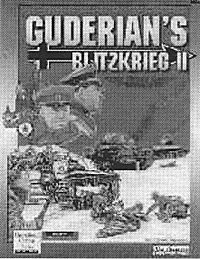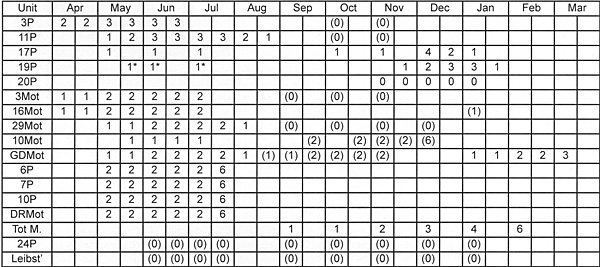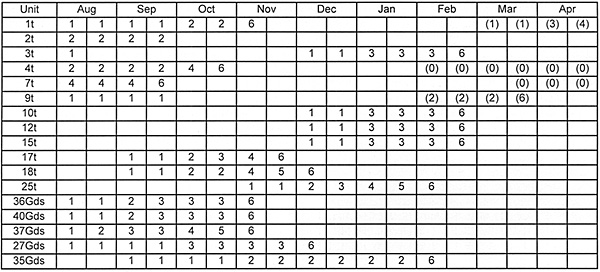 Back in June I sent Dean an e-mail asking
him if I could have an advance copy of the game
specific rules for Guderian's Blitzkrieg II (GBII)
(being a proud owner of all but one of the OCS
games who has already ordered GBIIJ - to read
on holiday. Dean being a thoroughly decent chap
e-mailed the rules back within a day (he'd never
have passed the entry test for OKW!!). Needless
to say the rules proved far too interesting to hold
back for the holiday. One Of the things that
struck me early on was, that I would need a
variable withdrawal and return mechanism for the
key divisions etc. that move into and out of Army
Group Center (AGC) during 1942. Any of you that
recall my article in Operations 16 may remember
that I have a bit of a hang up about trying to
recreate command uncertainties particularly in
respect of when units arrive on or leave the
gaming area.
Back in June I sent Dean an e-mail asking
him if I could have an advance copy of the game
specific rules for Guderian's Blitzkrieg II (GBII)
(being a proud owner of all but one of the OCS
games who has already ordered GBIIJ - to read
on holiday. Dean being a thoroughly decent chap
e-mailed the rules back within a day (he'd never
have passed the entry test for OKW!!). Needless
to say the rules proved far too interesting to hold
back for the holiday. One Of the things that
struck me early on was, that I would need a
variable withdrawal and return mechanism for the
key divisions etc. that move into and out of Army
Group Center (AGC) during 1942. Any of you that
recall my article in Operations 16 may remember
that I have a bit of a hang up about trying to
recreate command uncertainties particularly in
respect of when units arrive on or leave the
gaming area.
For the commander of AGC in 1942 the risk of losing units or delays to the arrival of reinforcements seemed significant. My thoughts led to the following rules -- which I freely acknowledge were influenced by similar rules in earlier OCS games.
The Basic System
For specified divisions or key assets (e.g. assault gun battalion) there is a series of target die rolls which can apply to the first and/ or middle turn of a month. For any month where a unit has no target die roll specified do not make one.
At the beginning of the relevant reinforcement phase roll a separate die for each unit that has a target die roll on the withdrawal/return table shown below. Adjust the die roll for any strategic modifiers that apply. If the resulting score is equal to or less than the target die roll then the relevant unit must be withdrawn within the current turn.
If the target die roll is in parenthesis then it relates to a unit returning to AGC from Army Group South (AGS) or the West. Of course, once a division has been withdrawn or returned then no future die rolls need to made except where a withdrawn unit has a target die roll for returning to AGC. (For example Gross Deutchland will probably be withdrawn from AGC in the spring and return later in the year.)
In some cases a unit has a target die roll of 0. In such cases the die roll is only made if there are strategic modifiers that would enable the modified die roll to equal 0. For example, on the 1 October '42 turn the 3rd panzer could only return to AGC if the strategic modifiers were applicable that could reduce the die roll from 1 or 2 to 0.
Strategic Modifiers
The more I thought about the 'whys' of this approach, the more I began to realize why Dean avoided "Hitler Directives" for GBIL However, here goes! I suggest that there are four key issues that constitute the strategic drivers that would influence the transfer of troops into or out of the gaming area:
The Success of AGS
Any transfer of units between AGC and AGS (apart from the initial allocation of units) is driven by the relative success of AGS. The more successful it is the less call there will be for units from AGC and the more chance there will be of units returning to AGC. This is particularly so between July 42 and Feb 43.
 For that period roll
two average dice each month and compare the
accumulated total to the historic AGS campaign
total for that month.
For that period roll
two average dice each month and compare the
accumulated total to the historic AGS campaign
total for that month.
There's no science in this just that the total of two average die rolls will usually be seven so there is limited chance of this strategic modifier coming into play - but the commanding officers will not be able to plan with quite so much certainty!
On a turn where the accumulated total exceeds the historic total by 3 or more then add 1 to all die rolls for withdrawals and deduct one from all die rolls for returns. In effect, AGS is doing well and doesn't so many troops.
On a turn where the accumulated total is 3 or more less then the historic total, then deduct 1 from all withdrawal die rolls and add 1 to all return die rolls. (AGS is doing badly and needs extra troops to shore up the front).
This is where things get really messy. But of course, the performance of AGC is almost as important as that of AGS however, here it's down to the players. The rule is a bit simple and if anyone wants to adjust\refine it please be my guest.
If AGC has captured Moscow then deduct 1 from all withdrawal die rolls and add 1 to all return die rolls. If the Russians have captured Smolensk, or has cut the Minsk/Smolensk railway west of Smolensk, the opposite applies, add 1 to withdrawal die rolls and deduct 1 from all return die rolls (needless to say action by partisans does not count). If the enemy recaptures Moscow or Smolensk, or regains control of the rail line the modifier ceases to have effect.
Operation Kremlin
These house rules are designed to apply to the historic scenario of AGS driving toward Stalingrad and into the Caucasus. The GBII scenarios include the scope for the Germans to launch an offensive on Moscow using the assets historically available to AGC. The early withdrawal of 17 and 19 panzer in May, June or July would not have occurred. Do not make those die rolls. The withdrawal of 6, Tand 10 panzer and the Das Reich division would have been less likely. For each of these divisions reduce the target die rolls for withdrawal to 1 for the period April 42 to July 42.
Operation Typhoon II
This is Dean's big hypothetical assault on Moscow in 1942 and it may be cited in a divorce case if it's as good as it looks!
Dean's scenario keeps 17, 19, 6, 7, and 10 panzer and Das Reich and GD Motorized divisions with AGC and therefore there are no withdrawal die rolls for these units in this scenario.
Any unit that is called for return to AGC from AGS should role a die for each component unit of the division - any unit rolling a six should be placed in the dead pile. This excludes any units that were in the dead pile when the division was transferred to AGS, they remain in the dead pile.
Corp HQs and attached units
There are seven corps HQs that can go to AGS, 40, 48, 57, and 24 panzer and the 5, 7, and 13 infantry corps. The infantry corps should be treated in accordance with the scenario instructions and the OOB. The panzer HQs should be with d rawn/retu rned in line with the movement of panzer/motorized divisions. So, for each pair of mechanized divisions (i.e. panzer or motorized) sent to AGS then send one panzer corps HQ - decide which of the above at random. These HQ's are eligible to return to AGC if the relevant mechanized divisions do so. In addition, if two or more mechanized divisions are withdrawn to the West then send another panzer corps HQ to AGS - this one never returns to AGC. No more than the four HQ's identified above can be sent to AGS.
All withdrawal target die rolls for 3 and 11 panzer, and 3, 16 and 29 motorized divisions are reduced to 1.
The return die rolls for 24 panzer and Liebstandarte are increased to 2 for the period June and July 1942.
The success of AGS strategic modifier is still used although only for 3 and 11 panzer and the 3, 16, and 29 motorized divisions. The assumption is that AGS will still launch an offensive but that it will be of limited scope - perhaps just to the west bank of the Don or perhaps to Stalingrad but not into the Caucasus before summer of 43? (bring on Case Blue Dean and I'll be able to test the theory!)
For each panzer corps HQ sent to AGS throw two dice. If the first roll is 1, 2, 3 or 4 withdraw a rocket regiment with the corps. If the second die roll is anything other than a 6 then withdraw an assault gun battalion (5-5-8) with the corps. These units do not return to AGC with the HQs under any circumstances.
To balance the basic 'South option withdrawal list', ignore the inclusion of the werfer regiments (51, 52 and 53) and the 55-8 assault gun battalions (177,210,243 and 203). All other units sent south should be dispatched as required by the list, including the 6 truck points in May 42.
Should any pair of mechanized divisions be returned to AGC then return one panzer corps HQ of your choice along with the second division - N.B. Only one corps HQ can be returned to AGC using this rule.
And so to the Russians
Here it seems sensible to focus on the tank corps and the guards infantry divisions - everything else going south as per the list. The target die rolls for the Russian units are shown on the table below. As with the German units subsequent rolls are not used after a unit has been sent to the South.
The Strategic modifiers for the success of AGS and the success of AGC should be used for the Red Army. Of course the modifiers used by AGC must be the same ones used by the Red Army - the success of AGS will be the same for both sides.
Kremlin and Typhoon II
The potential withdrawal of the 9th Tank corps should be ignored if either of these scenarios is being played. For all other tank corps reductions should be made to target die rolls in each of these scenarios. In the case of Kremlin reduce all target die rolls for tank corps that are greater than 3 by 1.
For example a target roll of 6 will be reduced to 5. In the case of Typhoon II reduce all the target die rolls for tank corps that are greater than 2 by 1. In the case of the guards infantry they are never withdrawn from the map if the Typhoon II scenario is being played. No additional
adjustments are made to target rolls for Guards infantry in the Kremlin scenario, it is assumed that they will only be retain in the Moscow area if AGC is has captured the capital!
Effect on emergency reinforcements
Use of these rules will affect the use of emergency reinforcements -- it is suggested that none of the forces of AGC that are subject to these rules should ever be available as emergency reinforcements. Any unit which is returned from AGS (or not transferred there in the first place) such as the Gross Deutchland remains on the map. In the case of the Russian divisions/corps, the transfer south (or return) takes priority and any unit that has been called up as an emergency reinforcement must be sent south if a relevant target die roll is made.


Back to Table of Contents -- Operations #47
Back to Operations List of Issues
Back to MagWeb Master List of Magazines
© Copyright 2005 by MultiMan Publishing, LLC.
This article appears in MagWeb.com (Magazine Web) on the Internet World Wide Web.
Other articles from military history and related magazines are available at http://www.magweb.com